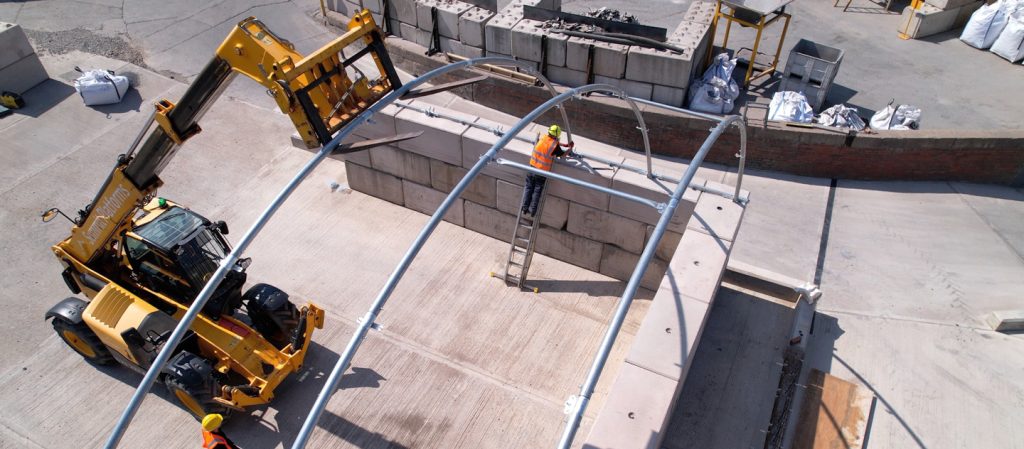In the world of construction, every decision can have far-reaching consequences on project timelines, budgets, and overall quality. Among these crucial decisions, the choice of aggregate storage option often stands out as a pivotal factor that can significantly influence the success of your construction endeavours. Proper storage of materials, particularly aggregates, is not just a matter of convenience; it’s a fundamental aspect of efficient site management, quality control, and regulatory compliance.
Aggregates, which include materials like sand, gravel, and crushed stone, form the backbone of many construction projects. From foundations to road bases, these materials play a critical role in ensuring the structural integrity and longevity of built environments but their effectiveness can be affected if not stored correctly. Exposure to the elements, contamination, and improper handling can all lead to degradation of material quality, increased waste, and potential project delays.
In challenging climates, the importance of choosing the right storage option becomes even more pronounced. With frequent rainfall, occasional extreme weather events, and stringent environmental regulations, construction professionals must carefully consider storage structures to protect materials and the bottom line.
This comprehensive guide aims to navigate you through the complex landscape of storage options, helping you make an informed decision that aligns with your project requirements, site conditions, and long-term operational goals. We’ll explore various storage structures, delve into the key factors that should influence your choice, and highlight innovative options reshaping the industry’s approach to material storage.
Understanding aggregate storage options
When it comes to storage options, construction professionals have a range of choices at their disposal. Each option comes with its own set of advantages and considerations, making it essential to understand the full spectrum before making a decision.
Covered storage bays offer a step up in protection and material management. These structures typically consist of three walls and a roof, providing shelter from rain and sun while allowing easy access for loading and unloading equipment.
Covered bays balance protection and accessibility, making them ideal for medium-sized projects. They help maintain material quality by reducing exposure to moisture and can facilitate better inventory control. However, they may still be susceptible to wind-driven rain and dust, depending on their design and orientation.
At the forefront of aggregate storage technology are enclosed aggregate storage systems. These sophisticated structures represent the gold standard in material protection and management. Fully enclosed systems offer comprehensive shelter from all weather conditions, significantly reducing the risk of material degradation, contamination, and loss.
They often come equipped with features like dust suppression systems, climate control options, and advanced inventory management tools. While the initial investment for enclosed systems may be higher, they can offer substantial long-term benefits in terms of material conservation, operational efficiency, and regulatory compliance.
Factors to consider when choosing an aggregate storage option
The selection of an appropriate storage option like an aggregate storage bay is a multifaceted decision that requires careful consideration of various factors. Understanding these elements will help you make a choice that not only meets your immediate needs but also supports your long-term operational goals.
1. Type and volume of materials
Different aggregates have varying sensitivities to environmental factors like moisture and temperature fluctuations. For instance, fine aggregates like sand may be more susceptible to wind erosion, while certain types of crushed stone might be more resilient to weather exposure. The quantity of materials you need to store will also influence the size and type of storage structure required. Large volumes may necessitate more substantial structures or multiple storage units, while smaller quantities might be adequately served by simpler structures.
2. Location conditions and space constraints
Site conditions and space constraints play a crucial role in determining the feasibility of different storage options. The topography of your construction site, available space, and proximity to other operations all factor into this consideration. Some storage structures require significant footprints, while others can be more compact or vertically oriented. It’s also important to consider the site’s drainage characteristics and soil stability, as these can affect the foundation requirements for your storage structures.
3. Financial implications
While initial costs are an important consideration, it’s equally crucial to evaluate the long-term financial implications of your storage choice. This includes factors like maintenance requirements, potential material loss due to exposure or handling, and the lifespan of the storage structure itself. More advanced storage options might come with a higher upfront cost but could offer significant savings over time through better material preservation and reduced waste. Additionally, consider the potential need for future expansions or modifications to your storage setup as your business grows or project requirements change.
4. Accessibility and material handling
Your storage structure should facilitate smooth, safe, and efficient loading and unloading processes. This might involve considerations like the width of bay openings, the height of walls for equipment access, or the integration of conveyor systems for automated material handling. The layout of your storage area should also support effective inventory management, allowing for easy stock rotation and reducing the risk of material segregation or contamination.

Make the right choice for your site with McGregor Opus
Investing in the right aggregate storage option is about more than just protecting materials; it’s about optimising your entire construction process. The right choice can enhance productivity, ensure consistent material quality, support regulatory compliance, and contribute to the overall success and profitability of your projects. By carefully weighing all the factors and considering innovative structures like the McGregor Opus, you can make an informed decision that sets the foundation for efficient, cost-effective, and high-quality construction operations.
